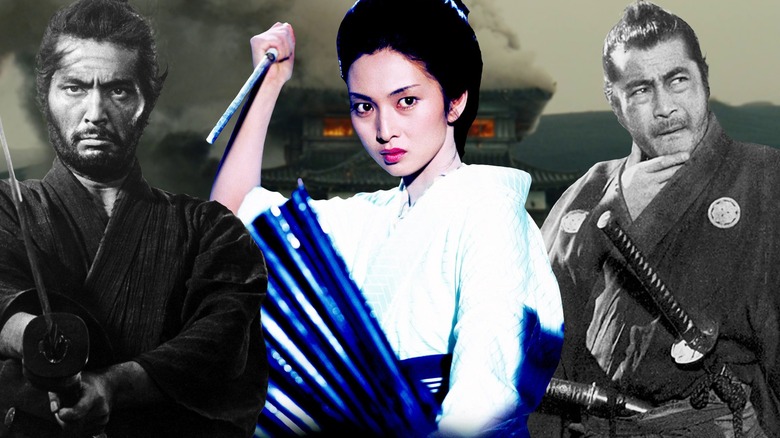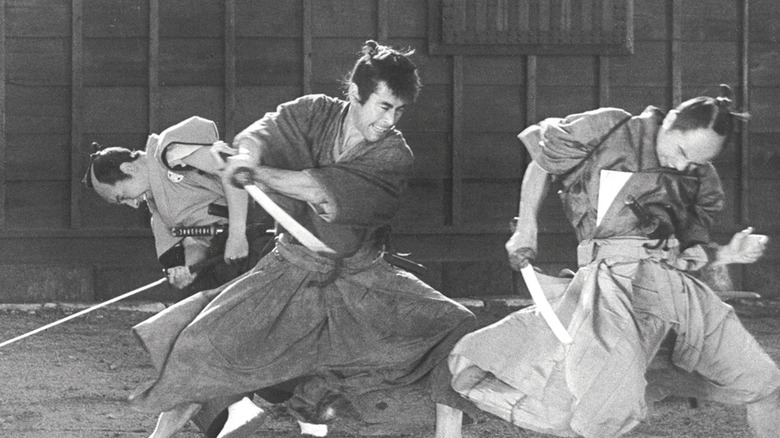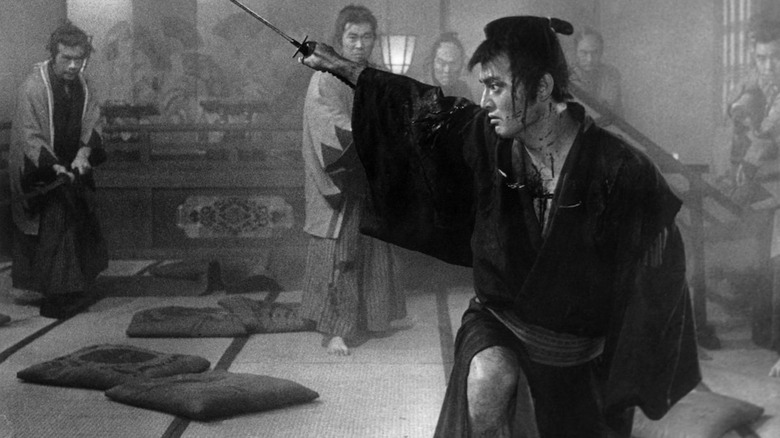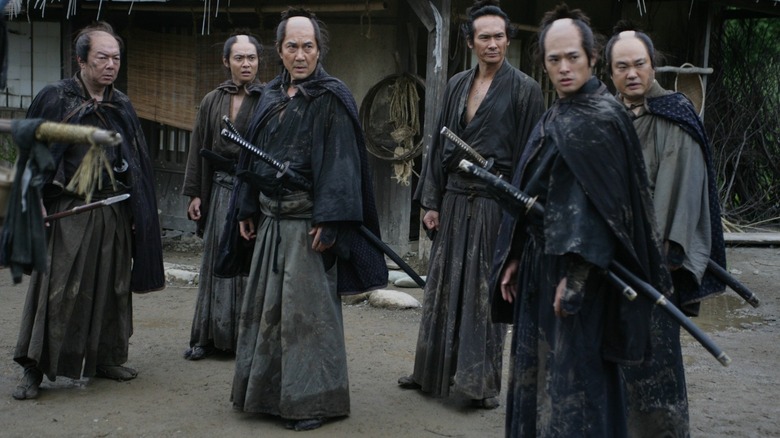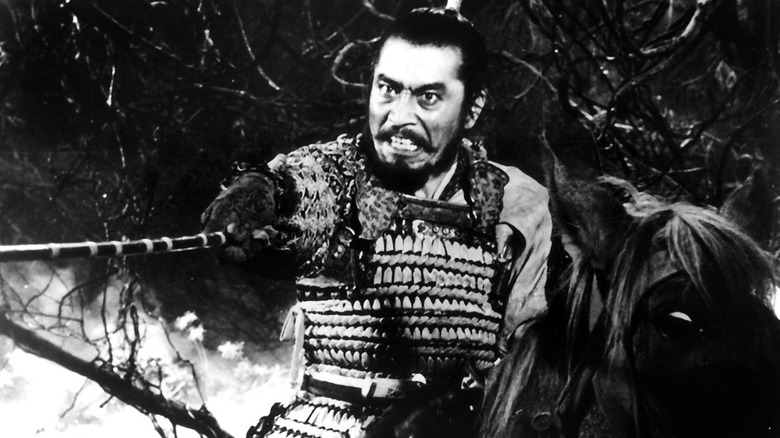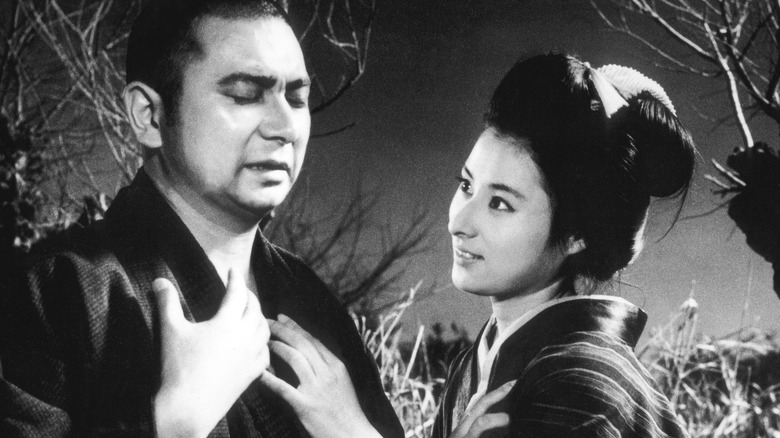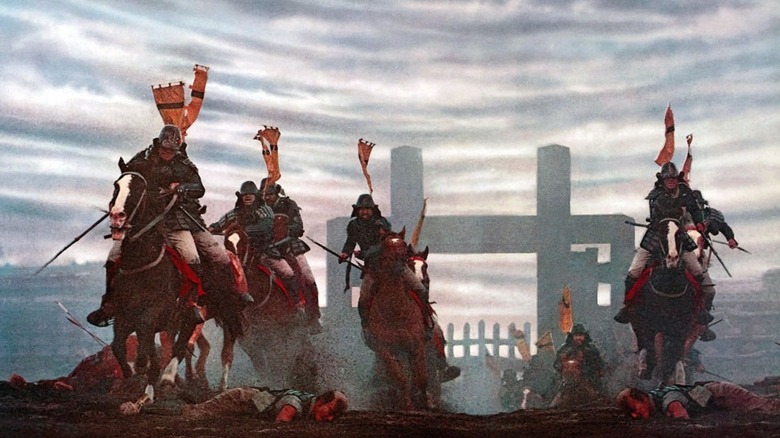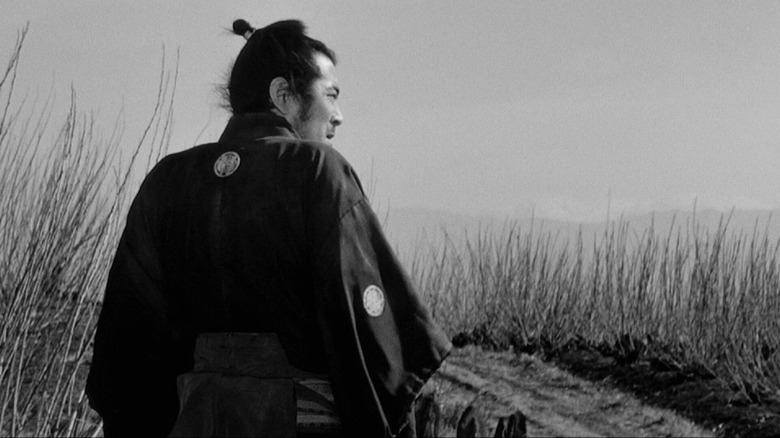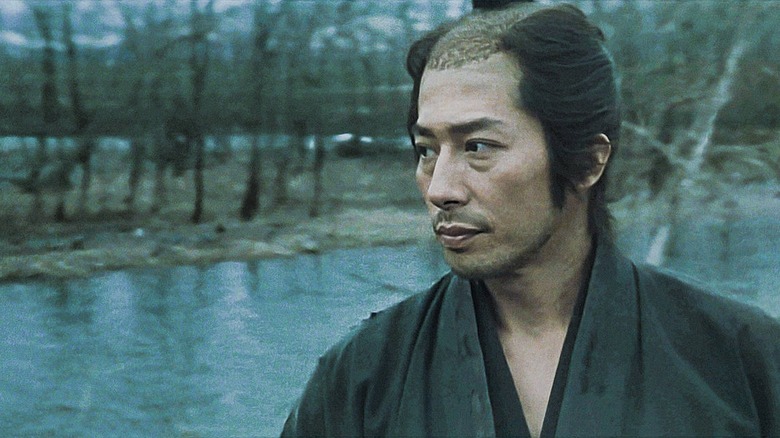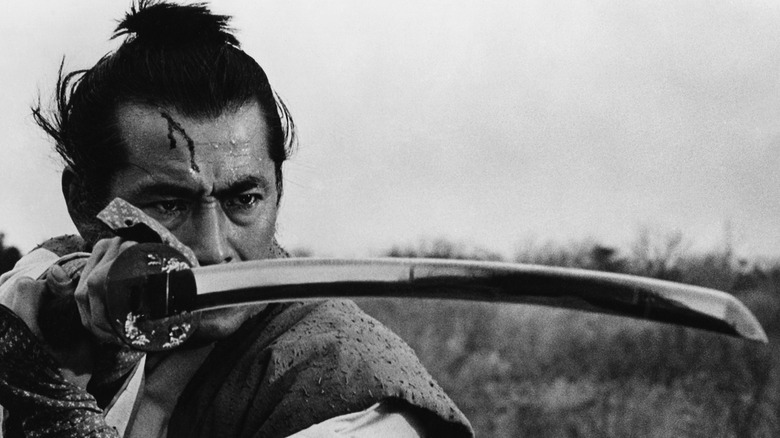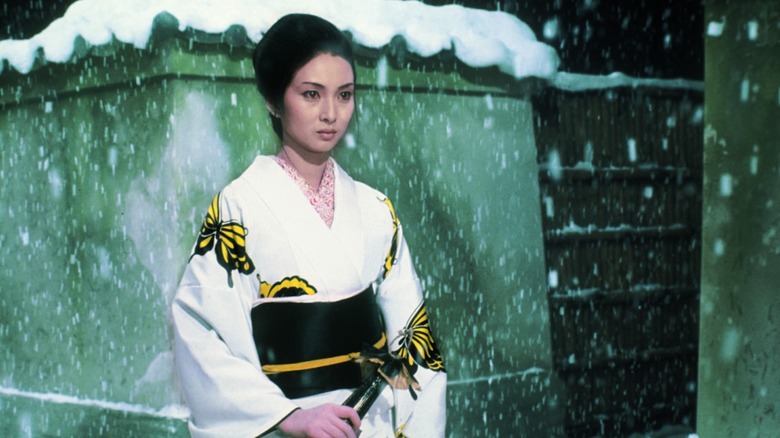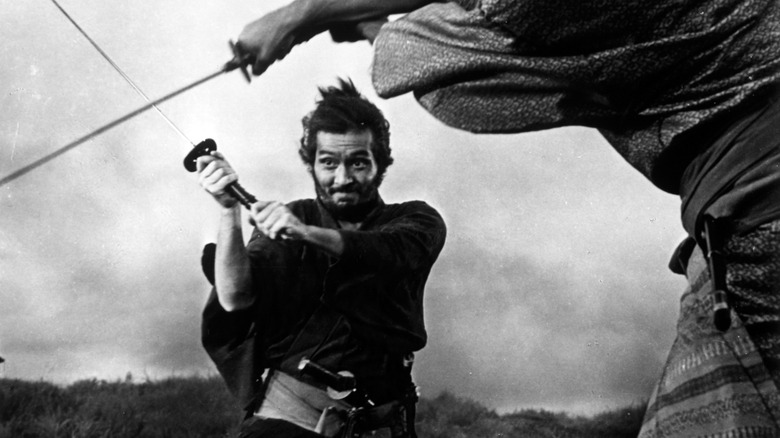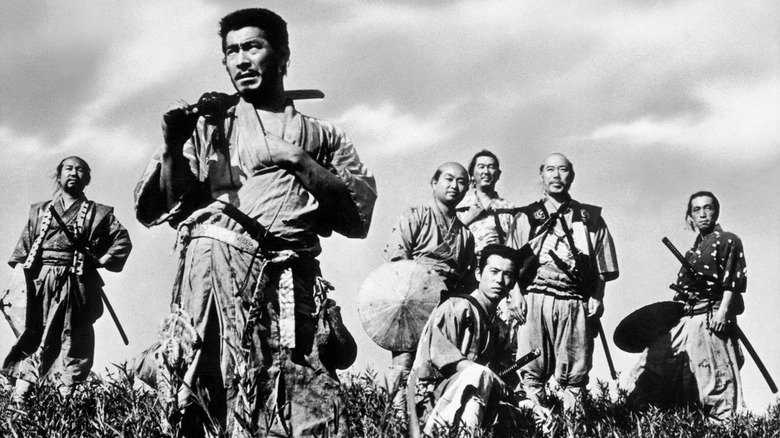The 12 Best Samurai Movies Of All Time
We may receive a commission on purchases made from links.
Samurai movies are a relatively new genre of film for Western audiences, having been popularized by famed Japanese director Akira Kurosawa's "Rashomon" and other films. These sparked the imaginations of hundreds of Japanese and foreign directors and writers, ushering in the new genre with some of the greatest movies ever made. Samurai movies aren't limited to Japan, as their influence can be seen in Western cinema to this day.
Films like "A Bug's Life," "A Fistful of Dollars," and "Star Wars" all owe their existence to the samurai film genre. Traditional samurai films include samurai warriors, a historical setting, which is often Japan's Edo (Tokugawa) period, and sword fighting. This forms the basis of the genre, and since their introduction, there have been hundreds of examples. It's not uncommon for one samurai movie to become a franchise, and films like "Yojimbo" received a sequel in "Sanjuro," thanks to the latter's popularity.
Because there are plenty of excellent samurai movies you need to watch, finding the best is challenging, as many hold 90-100% ratings on Rotten Tomatoes. Several factors were considered to determine the best: A film's reception upon release, how it's received now, an aggregate of its scores on IMDb and Rotten Tomatoes, and how they impacted the genre as a whole.
Samurai Assassin (1965)
"Samurai Assassin" is set in 1860, making it a somewhat rare example in the genre, as it comes just before the Meiji Restoration returned Imperial rule to Japan. This was a time of upheaval, especially for the samurai, whose position in society was diminished. In the film, Niiro Tsurichiyo (Toshirô Mifune) is the son of a powerful nobleman, a gifted swordfighter, and a social outcast. "Samurai Assassin" is something of a political thriller, pitting powerful clans against one another amidst the assassination of the shōgunate.
Tsurichiyo is a rōnin who allies with three clans, targeting the daimyō of Hikone, the man closest to daimyō Li Naosuke (Matsumoto Kōshirō VIII). This is because the shōgun intends to open the nation to foreign traders and diplomats, which had long been taboo in Japanese culture. Their assassination plot points to the gifted swordfighter, and it's all based on a real event known as the Sakuradamon incident, in which Li Naosuke was assassinated outside of Edo Castle in 1860.
The film features many of the tropes common to the genre, but the manner in which it was shot makes it almost seem like a theatrical play. "Samurai Assassin" presents itself as a historical reenactment of a pivotal moment in Japanese history shot with gorgeous widescreen best suited to the theater.
The Sword of Doom (1966)
In director Kihachi Okamoto's "The Sword of Doom," Ryunosuke Tsukue (Tatsuya Nakadai) is a master swordsman lacking any morality or adherence to the samurai code (Bushidō). He kills quickly and without remorse, including slaying his opponent in a non-lethal fencing competition. After seducing his opponent's wife, he slaughters many of the man's clansmen on his way out of town, though he's joined by the deceased man's widow.
Tsukue builds a life with his mistress and their son, but learns her dead husband's brother is out for revenge. He plans to meet and kill him, but is shaken to his core when he witnesses a better swordsman's skills. And after things take a dark turn between him and his mistress, the disgraced rōnin begins to feel emotions for the first time, showing remorse for all the people he killed, driving him insane.
"The Sword of Doom" explores the themes of honor, or more specifically, dishonor. Tsukue is driven mad by his remorseless killing, recalling the words of master swordsman, Shimada Toranosuke (Toshirô Mifune), "The sword is the soul. Study the soul to know the sword. Evil mind, evil sword." The film is extremely violent, but for a purpose, and it's all to do with the nature of a killer's blade.
13 Assassins (2010)
The 1963 film "13 Assassins" is a classic and worth watching, but the film's remake in 2010 is one of the most underrated action movies from the last decade. The film is set in 1844, toward the tail end of the Edo period, and focuses on 13 assassins made up of 12 samurai and a hunter. They plot to assassinate daimyō Matsudaira Naritsugu (Gorō Inagaki), the leader of the Akashi clan. This comes as the Tokugawa Shōgunate is in serious decline, and Naritsugu is a vicious and unrelenting daimyō terrorizing his people.
After he's appointed to the Shōgunate Council, many feudal lords cry out in protest, leading daimyō Doi Toshitsura (Mikijirō Hira), the Justice Minister, to order Naritsugu's assassination. News of the plot leaks and the 13 assassins hired to carry it out are hounded by those loyal to the shōgunate. They establish a series of traps at the village of Ochiai, leading to a massive battle that is incredibly violent, bloody, and decidedly conclusive.
"13 Assassins" concludes with one of the most beautifully choreographed and shot battle scenes in modern movie history. It extends for over 45 minutes, beginning with ranged weapons before swords and spears are drawn. The final battle alone is reason enough to watch this film, as is the political intrigue that beautifully illustrates the final days of the samurai in Japanese history.
Throne of Blood (1957)
Akira Kurosawa is arguably the greatest samurai film director in history, and he's a rare example of a director who never made a bad movie. Kurosawa absolutely loved William Shakespeare's work, and he adapted many of the Bard's plays. "Throne of Blood" is one such film, retelling Shakespeare's "Macbeth" — though the story is transposed from Scotland to Japan, featuring the style of Japanese Noh theater, a classical Japanese theatrical dance drama.
Toshirô Mifune plays Taketoki Washizu, the Macbeth character, and the film begins with him and fellow samurai warrior Yoshiaki Miki (Minoru Chiaki) meeting an evil spirit in a forest who foretells their destinies. Washizu will become the daimyō of the Spider Web Castle, while Miki's son will become a daimyō, succeeding him. Various machinations lead to a plot of murder to ensure parts of the prophecy are fulfilled. This leads to numerous deaths and an assault on the castle that ends tragically.
Like the play upon which it's based, "Throne of Blood" details the unavoidable consequences of human ambition and the nature of destiny. "Throne of Blood" is one of the best adaptations of "Macbeth" put to celluloid, and it's also one of Kurosawa's greatest pictures. The blending of Western elements with Japanese theater takes a familiar story and recreates it into a modern masterpiece that no fan of the samurai film genre should miss.
The Tale of Zatoichi (1962)
There are many notable characters in samurai film history, and Zatoichi is one of the most beloved. He was first introduced in 1962's "The Tale of Zatoichi," spawning a franchise consisting of 26 films and several modern remakes. The first film establishes the character, played by Shintaro Katsu. Zatoichi "Ichi" is a blind masseur working for the Yakuza, and more than that, he's a renowned swordfighter and samurai with incredible abilities centered around his remaining senses.
Ichi is widely disrespected because of his occupation, but he's also misjudged for being blind, which is detrimental to the health of anyone who draws a sword in his presence. He's respected and befriended by a rōnin named Miki Hirate (Shigeru Amachi), who wishes to fight his friend due to his failing health and his desire to die with his sword in his hand. Meanwhile, Yakuza Shigezo (Ryūzō Shimada) plots to kill Ichi, leading Hirate to intervene.
This culminates in a duel, leaving Ichi a lone warrior. There are many exceptional films in the "Zatoichi" franchise, but "The Tale of Zatoichi" is arguably the best. It retains a 100% on Rotten Tomatoes, and establishes the character in a manner that makes viewers want to watch more. Zatoichi has influenced cinema in and out of Japan, including "John Wick: Chapter 4's" Caine, brilliantly played by Donnie Yen.
Ran (1985)
Director Akira Kurosawa returned to William Shakespeare's works for what many consider to be his finest film, "Ran." The movie is inspired by the historical daimyō Mōri Motonari and his three sons. Kurosawa took inspiration from this historical family and interjected the plot of Shakespeare's "King Lear," making "Ran" the director's final adaptation of the Bard's work. Tatsuya Nakadai plays Hidetora Ichimonji (the King Lear role), an elderly warlord who chooses to abdicate in favor of his sons.
Ichimonji's plan is to divide his domain equally among his three sons, Taro (Akira Terao), Juro (Jinpachi Nezu), and Saburo (Daisuke Ryu), with the two youngest supporting the eldest, Taro. Unfortunately, Saburo disobeys his father's insistence of obedience and is banished. This leads to a massive military conflict between the brothers, culminating in an outcome reminiscent of Shakespeare's truly tragic work that inspired the film.
In addition to its brilliant story, phenomenal score, gorgeous period costumes, and excellent acting, the cinematography of "Ran" has been highly praised. It's one of Kurosawa's most beautiful films, and is the epitome of the director David Lean's notion that gave rise to the phrase, "every frame a painting." "Ran" is also the only film to earn Kurosawa an Academy Award nomination for best director. While he didn't win, Emi Wada received the Oscar for best costume design.
Yojimbo (1961)
"Yojimbo" is set during the twilight of the samurai in 1860 and is centered around a rōnin named Kuwabatake Sanjuro (Toshirô Mifune). Sanjuro wanders through the countryside until he comes to a farmhouse, asking for water. He hears the farmer and his wife argue about their son, who's taken up with one of the two yakuza gangs in the nearby town. Sanjuro leaves and arrives in the town, where he learns more about the warring yakuza and is advised to leave — he declines.
Sanjuro is approached by both sides of the conflict, and he works for each gang, playing one against the other. In several confrontations, he deftly slays his enemies, often when facing multiple swordsmen at once. Before long, he escalates the gang war, making things worse for both sides. This is done deliberately, as he correctly surmises that neither gang is interested in stopping their ongoing, bloody war.
Sanjuro develops the situation into an all-out conflict, saving the farmer's son in the end. "Yojimbo" was so successful that director Akira Kurosawa restructured his next movie, "Sanjuro," into a sequel. That film also did incredibly well and continued to show the powerful, ongoing partnership between Kurosawa and Mifune. It also inspired Italian director Sergio Leone to create "A Fistful of Dollars," which lifted its plot from "Yojimbo," though it's hardly the only movie inspired by Kurosawa's work.
The Twilight Samurai (2002)
"The Twilight Samurai" is based on a short story called "The Bamboo Sword," written in 1976 by Shuhei Fujisawa, which was expertly adapted into one of the best samurai films of the past half-century. The movie is set in the mid-1800s, shortly before the Meiji Restoration. It focuses on a low-ranking samurai named Seibei Iguchi (Hiroyuki Sanada), who is a poor widower working as a lowly bureaucrat.
He lives a relatively peaceful life, caring for his daughters and sick mother, but his fellow samurai mockingly call him "Tasogare" (Twilight) behind his back. Iguchi's quiet life is forever changed when an old friend, Tomoe Iinuma (Rie Miyazawa), comes to town. Her ex-husband barges in, and Iguchi is forced to accept a duel against him. The duel ends with Iguchi sparing his foe's life, but his prowess with the blade earns the respect of the clan leader, who orders him to kill a man who refused to die by seppuku.
Reluctantly, Iguchi accepts, leading to a decisive duel and an epilogue that is more realistic than in most films. "The Twilight Samurai" is about a man who wants nothing more than to care for his family — he's disinterested in improving his status in the clan and only cares deeply for the people closest to him. His story is one of love, not death.
Samurai Rebellion (1967)
Director Masaki Kobayashi's "Samurai Rebellion" is set in 1725, during the Edo period, and stars Toshirô Mifune as Isaburo Sasahara, a vassal of daimyō Matsudaira Masakata's Aizu clan. When the daimyō orders Sasahara's eldest son, Yogoro (Go Kato), to marry his former concubine, Ichi (Yoko Tsukasa), the family reluctantly agrees. The marriage works out, and the two fall in love and have a daughter, but their happiness becomes moot when the daimyō's heir dies.
He orders Ichi to return to his household, but the family refuses, leading to condemnation and threats of seppuku. Later, the daimyō's steward accompanies 20 samurai to the house to force Ichi to renounce her marriage. Instead, she throws herself onto a spear, and Yogoro is killed when he rushes to her side. This leads Sasahara to slaughter the steward's entire party of 20 warriors, saving the steward for last. He decides to take his case to the shōgun, but his story ends before this happens.
Revenge stories are rarely as well told as "Samurai Rebellion," which is a Western adaptation of the Japanese title that is better translated to "Rebellion — Receive the Wife." Mifune's impeccable talent is on full display throughout his time on screen, and his passionate portrayal of a man with nothing to lose is part of why this film retains a 100% on Rotten Tomatoes.
Lady Snowblood (1973)
Most samurai films are centered around men, as they made up the majority of the class. Still, onna-bugeisha (female samurai) existed, and "Lady Snowblood" is a glorious example of this type of warrior. The film is based on Kazuo Koike and Kazuo Kamimura's manga series of the same name and stars Meiko Kaji as Yuki Kashima, a woman who seeks vengeance upon the men who raped her mother and killed her half-brother.
The film is unusual, as it's told in a non-linear format, jumping back and forth from the present to the past. "Lady Snowblood" is set in 1874, after the Meiji Restoration, when Sayo Kashima (Miyoko Akaza) gives birth to a girl inside a women's prison. She names her Yuki (Snow) and dies soon after wishing for the child to gain vengeance for her. 20 years later, Yuki works as an assassin, but her primary goal is finding the men who destroyed her family, which she does methodically and with furious anger.
"Lady Snowblood" lives up to its name, as it's incredibly violent and one of the best classic revenge thrillers to come out of Japan. It heavily influenced Quintin Tarantino's "Kill Bill" films, which focus on a female samurai warrior intent on revenge.
Harakiri (1962)
One of the cultural nuances in Feudal Japanese society was seppuku, the act of ritual suicide, also called "harakiri." That's also the title of director Masaki Kobayashi's classic samurai film set in the 17th century. It focuses on a rōnin named Hanshirō Tsugumo (Tatsuya Nakadai), who requests to die by seppuku inside the manor of the daimyō of the Iyi clan, which wasn't an unusual practice during the Edo period.
The story begins with Tsugumo arriving at the palace and recanting his life over the past 11 years, which drove him to that point. There's an attempt to dissuade him, citing recent events, but he's committed. The three samurai he requests to behead him refuse to attend, citing an illness. While awaiting the messengers' return, Tsugumo tells his life story to the gathered samurai, detailing how his adopted son was killed and mocked by the three men he summoned.
He then reveals how he disgraced them, leading to a massive battle between Tsugumo and the clan, destroying their antiques, and is shot as he dies by seppuku. This dishonors the entire clan, but they lie to the shōgun, burying the truth of what happened by covering up their failure to honor the bushidō. "Harakiri" is widely regarded as one of the greatest samurai films ever made, which isn't surprising, given its 100% rating on Rotten Tomatoes.
Seven Samurai (1954)
Director Akira Kurosawa made nine samurai movies, and the one most often cited as his greatest is "Seven Samurai." The film is set in 1586 when a bandit gang plans to raid a mountain village to steal the villagers' grain. But the villagers overhear this and travel to a town nearby, where they find a rōnin whom they ask to help them. He reluctantly agrees and recruits more samurai to help, ultimately finding six. After arriving at the village, the samurai learn the futility of the villagers' plight and decide to train them and establish defenses to prepare for the bandit gang's arrival.
With some effort, the samurai inspire the villagers, and they strengthen them into a reasonable fighting force. In their initial assault, many bandits are killed, though so are some villagers. The bandits continue to press their attack, and the following morning, the villagers lead them into an ambush at the center of the town. This leads to a massive fight, resulting in the deaths of several samurai, and a victory for the village.
"Seven Samurai" isn't merely an exceptional samurai film – it also inspired numerous remakes and reimaginings. If you've never seen it but recognize the story, you're probably familiar with "The Magnificent Seven," "A Bug's Life," and others. Its impact on the genre, as well as film history itself, is undeniable, making it one of the greatest samurai movies ever.
